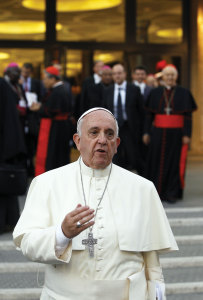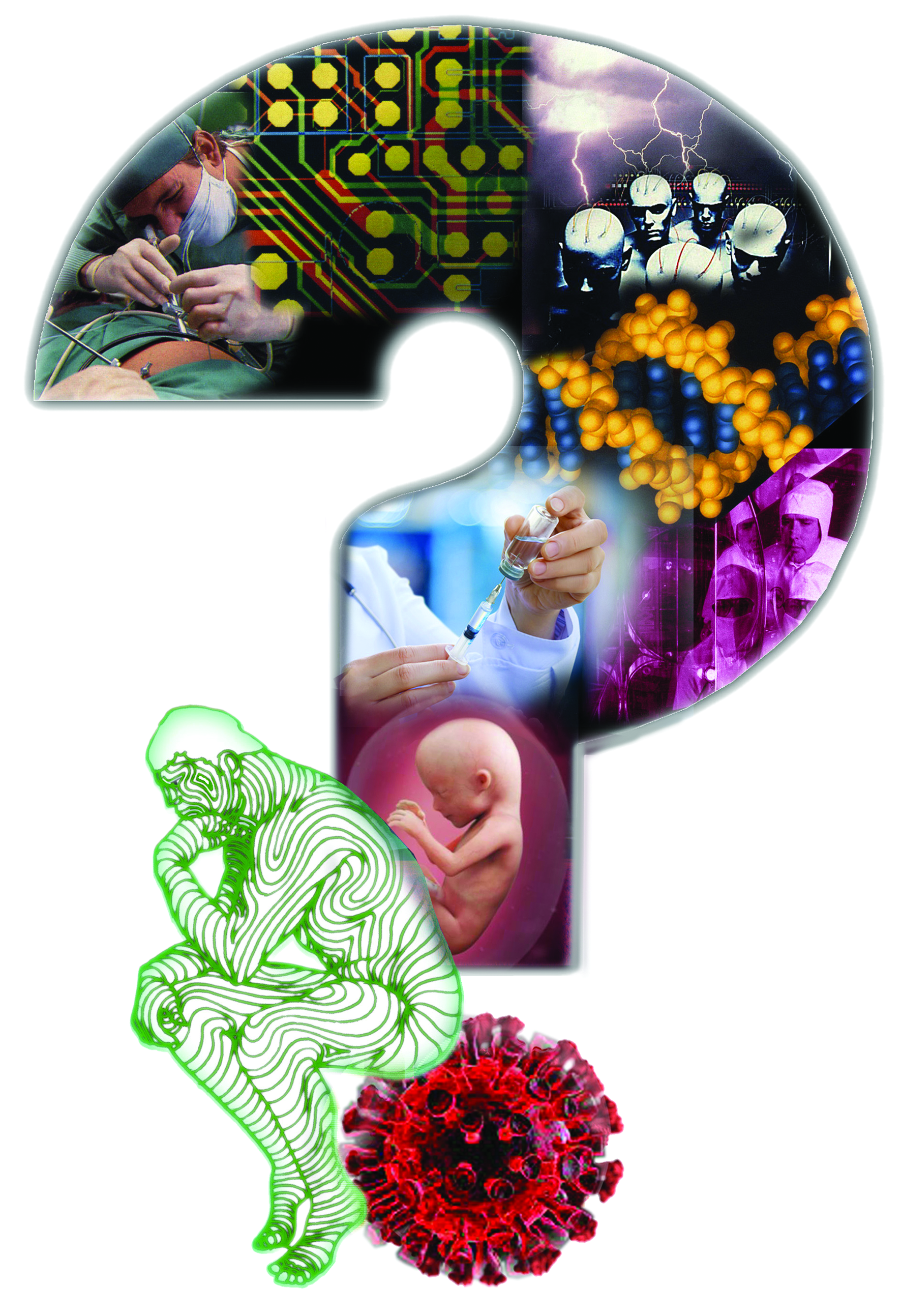
Pope Francis thanks the media as he leaves the concluding session of the extraordinary Synod of Bishops on the Family at the Vatican October 18.
One Synod took place inside the Synod Hall from October 5 to 19. The other Synod took place outside the hall… in the world’s media.
On October 19, the synod closed with the voting on the final report and with a final address by the Pope, which was greeted with a prolonged standing ovation. The week of high drama ended with a great sigh of relief: schism, which seemed imminent, had been avoided.
On most issues, a near unanimity had been established. The final report, with the exception of three paragraphs out of 62, had been approved by an overwhelming majority. The report is a impressive document, considering that is was the product not just of one but of several committees. Even more impressive was the closing message from the synod fathers to families, which is almost poetic at times. It is Franciscan in tone. Both it and the main content of the final report were almost totally ignored by the media.
Instead, the secular media highlighted the three paragraphs that did not achieve the required two-thirds majority: in particular, the one dealing with same-sex relations (number 55).
Some media coverage gave the impression that the extraordinary synod was primarily devoted to same-sex relations. The one paragraph that did mention the topic rejected discrimination, as could be expected, and rightly called for sensitivity in dealing with persons in such relationships, but it also reiterated Church teaching on the matter, including the rejection of any attempt to equate same-sex unions even remotely with marriage. What the media ignored was paragraph 56, which was approved by an overwhelming majority. It rejected, in effect, the attempt to intimidate Church pastors with regard to this question, as well as taking international organizations to task for linking aid to poor countries with legislation for so-called “marriage” of people of the same sex.
In a sense, there were two synods taking place, one inside the Synod Hall and the other in the media. And the media, whether secular or Catholic, cannot be entirely blamed for this. They had to interpret the selectively-leaked information from what have been an open synod — and naturally each side chose whatever fitted their own particular agenda or concern. Catholicism and sex is a heady mixture that fascinates the Western media.
Media coverage can be like a hall of distorting mirrors. The distorted images of the Synod deliberations fed into the public’s expectations and/or fears. They fueled the initial confusion caused by the way the first week of the synod was manipulated by those who were convinced that they acting according to the mind of Pope Francis.
Inside the synod, things were, by all accounts, quite different.
The actual situation was summed up by the Pope in his closing address.
The synod was an exercise in real collegiality and rare frankness. He referred to the ups and downs, the tensions and excitement of a sometimes very heated debate between committed pastors, albeit coming from different perspectives, some radically different. It was a battle of the titans. Some of the drama leaked out and made the headlines. The final report came as a real surprise. It is not a great literary masterpiece, but it is a document rooted in good theology and sensitive to the myriad problems that beset marriage, the family, children, and single people today.
Pope Francis concluded his address by quoting his immediate predecessor extensively. The supreme rule of conduct for all the ministers of God is, Benedict XVI wrote, “an unconditional love, like that of the Good Shepherd, full of joy, given to all, attentive to those close to us and solicitous for those who are distant […], gentle towards the weakest, the little ones, the simple, the sinners, to manifest the infinite mercy of God with the reassuring words of hope [quoting St Augustine].”
The Pope, in Francis’ own words, “is not the supreme lord, but rather the supreme servant of the servants of God; the guarantor of the obedience and the conformity of the Church to the will of God, to the Gospel of Christ, and to the Tradition of the Church, putting aside every personal whim, despite being by the will of Christ Himself the supreme Pastor and Teacher of all the faithful […] and despite enjoying supreme, full, immediate, and universal ordinary power in the Church [quoting Canon Law].”
And then he added the most telling sentence of all: “And this should never be seen as a source of confusion and discord.” But it was.
The well-meaning campaign by Cardinal Walter Kasper, backed by most (but certainly not all) German and Italian bishops, to promote his own novel proposal to grant (some) remarried divorcees admission to the sacraments, was the cause of that confusion and discord. The cardinal claimed that he had Pope Francis’ backing.
That campaign and the media coverage it received, particularly by more so-called “progressive” Catholics, caused acute distress to those others, who, at no little personal cost, try to remain true to the Magisterium. They feel that they are ones who are marginalized in the Church. One priest confided to me that his faith has been severely tested over the past 18 months. He was not alone.
Yet there must be some truth to Cardinal Kasper’s assertion. And I think it is to be found in the Holy Father’s intense desire to embrace the sinner as Christ did. His whole pontificate manifests that love. It is the love of the anxious father waiting for the Prodigal Son to return to his loving embrace. Many who went astray, and who for years felt lost and abandoned by the Church, or many outside the Church, who (falsely but understandably) perceived her moral teaching as rigorous, have come back to receive forgiveness and absolution in Confession. Considering this alone, the price those who have tried to remain true to the Magisterium of the recent Popes have had to pay, in terms of being marginalized within the Church, has been worth it.
The final report quotes from the Magisterium of St. John Paul II and Benedict XVI. It also more faithful to Humanae Vitae than the mid-term report. At the beatification last Sunday, Francis praised Paul VI’s courage. He said: “When we look to this great Pope, this courageous Christian, this tireless apostle, we cannot but say in the sight of God a word as simple as it is heartfelt and important: thanks!” And then he exclaimed, as the faithful applauded: “Thank you, our dear and beloved Pope Paul VI! Thank you for your humble and prophetic witness of love for Christ and his Church!”
That was the only reference to Humanae Vitae, but, oblique though it was, it was hugely significant.
Pope Francis, it seems, is aware of the tendency to self-righteousness and rigorism in those who, at times all too vociferously, defend the Church’s highly contentious moral teaching, and so he uses every opportunity to exercise fraternal correction towards them, as he did in his concluding address to the Synod. He also seems to be aware of the tendency among priests and bishops who, out of sympathy for hard cases, reject the recent papal magisterium.
In the same concluding address, Pope Francis warned them of “[t]he temptation to come down off the Cross, to please the people, and not stay there [on the Cross], in order to fulfil the will of the Father,” and he further warns them about the tendency “to bow down to a worldly spirit instead of purifying it and bending it to the Spirit of God.”
The special Petrine mission of the present Holy Father could be summed up in Jesus’ High Priestly Prayer: “That all may be one” (Jn 17:21). And that is the purpose of the whole process of this unique Synod of Bishops extending over 12 month, which, paradoxically, thanks to the media, has now involved the whole Church in a way that can only be dramatic and risky. But it is a risk that is worth taking.


Facebook Comments